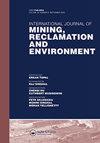电池小车矿用卡车车队生产率估算
IF 2.6
3区 工程技术
Q3 ENVIRONMENTAL SCIENCES
International Journal of Mining Reclamation and Environment
Pub Date : 2023-11-03
DOI:10.1080/17480930.2023.2278013
引用次数: 0
摘要
摘要采矿业面临着减少碳排放的紧迫挑战。采矿卡车车队运输材料是减少排放的一个关键因素。随着行业逐渐用更环保的运输系统取代柴油卡车,分析新的解决方案非常重要。本文介绍了一种新型的采矿卡车车队,称为电池手推车系统,它结合了先进的技术,包括电池-电动传动系统、自动驾驶、手推车辅助和能量回收系统。根据具体站点的差异和采用的技术,决策者有三种Battery Trolley系统配置可供选择:动态充电、固定充电和双台车Battery Trolley系统,每种系统都有自己的优点和缺点。使用电池小车系统的挑战之一是它们的容量和生产率。本研究使用开放访问的项目参数和数据库,并结合工程假设,为动态收费和固定收费视角创建采矿场景。研究提供了电池小车系统采矿生产力的评价公式。结果表明,在不同的电池台车配置下,随着台车功率从8兆瓦增加到32兆瓦,电池台车生产率的增量分析。该研究比较了电池小车在几种露天矿开采应用中的生产率,包括铜、铁和覆盖层废物。结果表明:(1)台车功率限制显著影响电池台车系统的容量;(ii)与动态充电相比,固定充电可实现更高的容量和生产率;(iii)在给定的仿真假设下,电池小车的生产率在不同的应用中是不同的。关键词:脱碳电池电车电池电动卡车电气化采矿能力和生产率披露声明作者未报告潜在的利益冲突。本文章由计算机程序翻译,如有差异,请以英文原文为准。
Productivity estimation of battery trolley mining truck fleets
ABSTRACTThe mining sector is facing an immediate challenge to reduce its carbon emissions. The movement of material with mining truck fleets is a critical factor in reducing emissions. As the industry gradually replaces diesel trucks with more environmentally friendly transportation systems, it is important to analyse new solutions. This paper presents a new type of mining truck fleet called the Battery Trolley system, which is a combination of advanced technologies, including a battery-electric drivetrain, autonomy, trolley assist, and energy recovery systems. Depending on the site-specific differences and technology adoptions, decision-makers have three Battery Trolley system configurations to choose from: dynamic charging, stationary charging, and dual trolley Battery Trolley systems, each of which has its own advantages and disadvantages. One of the challenges of using Battery Trolley systems is their capacity and productivity. This study uses open-accessible project parameters and databases, with engineering assumptions, to create a mining scenario for both the dynamic charging and stationary charging perspectives. The study provides an equation to evaluate the Battery Trolley system’s mining productivity. Results show an incremental analysis of the Battery Trolley productivity as the trolley power increases from 8 MW to 32 MW in various Battery Trolley configurations. The study compares the Battery Trolley productivity for several open-pit mining applications, including copper, iron, and overburden waste. The results indicate that: (i) trolley power limitations significantly affect the capacity of Battery Trolley systems; (ii) a stationary charging option can achieve higher capacity and productivity than dynamic charging; (iii) Battery Trolley productivity varies in different applications under the given simulation assumptions.KEYWORDS: DecarbonisationBattery TrolleyBattery-electric trucksElectrificationMining capacity and productivity Disclosure statementNo potential conflict of interest was reported by the authors.
求助全文
通过发布文献求助,成功后即可免费获取论文全文。
去求助
来源期刊

International Journal of Mining Reclamation and Environment
ENVIRONMENTAL SCIENCES-MINING & MINERAL PROCESSING
CiteScore
5.70
自引率
8.30%
发文量
30
审稿时长
>12 weeks
期刊介绍:
The International Journal of Mining, Reclamation and Environment published research on mining and environmental technology engineering relating to metalliferous deposits, coal, oil sands, and industrial minerals.
We welcome environmental mining research papers that explore:
-Mining environmental impact assessment and permitting-
Mining and processing technologies-
Mining waste management and waste minimization practices in mining-
Mine site closure-
Mining decommissioning and reclamation-
Acid mine drainage.
The International Journal of Mining, Reclamation and Environment welcomes mining research papers that explore:
-Design of surface and underground mines (economics, geotechnical, production scheduling, ventilation)-
Mine planning and optimization-
Mining geostatics-
Mine drilling and blasting technologies-
Mining material handling systems-
Mine equipment
 求助内容:
求助内容: 应助结果提醒方式:
应助结果提醒方式:


